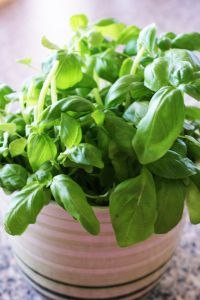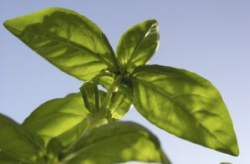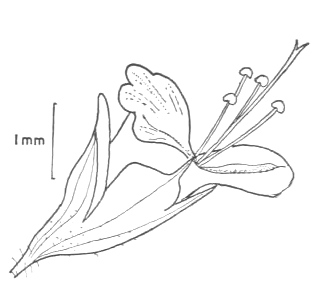
Now and again, I see people visiting Our Herb Garden who are looking for information on the different basil varieties available. I started out in the naive belief that I would need around half a day to put something together. Order, family, genus, species, cultivar – terms I hadn’t used since high school. How hard could it be to write about the different varieties of basil?
Oh, was I in for a rude awakening.
Species, variety and cultivar appear to be used with reckless abandon even by folks who should know better. It seems there are somewhere around 33 species of basil and as many as 200 varieties or cultivars of basil. There are annuals, perennials and shrubs. There are sweet basil varieties, spicy, fruity and licorice flavored varieties of basil. The leaves can be tiny or as big as lettuce leaves. The flowers range from bright white to purples that are almost black. Basil plants can have green leaves, purple leaves and even red leaves.
Basil apparently cross-pollinates easily – one scientific paper referred to it as “promiscuous.” Some of the species and cultivar names are being used interchangeably and I suspect more than a few sites are providing inaccurate information. Even scholarly sources seem to contradict themselves. And, just in case there wasn’t enough confusion, some portions of the genus have been reclassified in recent years.
I thought I would start at the beginning.
Let’s get the really easy one out of the way, we are talking about living organisms from the Kingdom of Plantae – i.e., plants.
Basils are in the order Lamiales – flowering plants, whose first leaves or seed leaves grow as a pair (known by the scientific term dicotyledons). Other well-known garden plants in this order include jasmine, lavender, lilac, mint, olive, rosemary and snapdragon.
Lamiaceae or Labiatae is the mint or deadnettle family of plants. This group includes basil, hyssop, lavender, marjoram, mint, oregano, sage, thyme and rosemary.
Now we are to the basils – genus Ocimum.
There’s a shorthand and method to how cultivars are named. The best article I found that explains how it all works together is on the Floridata website. The naming of species is a bit of first come, first named for. When a name is accepted but later considered to be what amounts to a duplicate, it is reclassified as a synonym. But, unlike the words ‘pretty’ and ‘lovely’ the two scientific names are not interchangeable. The accepted name is the only one that should be used.
When discussing the various species, scientists will often abbreviate the genus name with the first letter. Ocimum basilicum becomes O. basilicum.
I was able to find information on 11 of the basil species. In time, this page will link to more detailed information about a selection of basil cultivars and where you can buy seeds and plants.
americanum
Ocimum americanum is also known as American, lemon basil, wild basil and “hoary” basil. The origins of this species of basil are tropical Africa and Asia. They generally grow 1-3 feet tall and are somewhat bushy. One historic work described the growth habit as looking like a broom. This species tends to prefer sunny, wind-sheltered conditions. Small leaves grow in pairs with larger separations along the stem than some of the other basil varieties. The leaves have an intense lemon scent. Flowers are typically white to whitish lilac.
Cultivars include lime basil.
It seems these tender perennials which require protection in colder climates.
basilicum

Ocimum basilicum is the species of basil that is most commonly used in cooking. It is also called sweet basil, common basil and sometimes Thai basil. Most commercially sold cultivars are sweet basil.
O. basilicum generally blooms from June to frost. The flowers are described as magenta. These annual herbs like full sun and well-drained soil with regular watering.
Cultivars include: lime basil, boxwood, horapha (anise basil), napolatano, genovese, lettuce leaf, nufar, purple ruffles, queen of sheba, sweet dani, sweet large leaf Italian, Thai Siam queen and Well-sweep miniature purple. At least one site recommended Sweet Genoese/Genovese Profumitissima as being the the variety with the truest basil flavor.
campechianum
Ocimum campechianum is not actually a basil, as we know them, despite being listed in the Ocimum genus. (I did mention all of this is confusing, right?) This Amazon native has essential oils that are comparable to the essential oils of common basil and thyme. It is also known as Amazonian basil, wild sweet basil, wild mosquito plant, least basil, Peruvian basil, spice basil, alfavaca-do-campo, manjericao and estoraque.
Plants generally grow only up to 18 inches tall. Flowers are pinkish-lavender or white. It has naturalized in South America and the southernmost portions of Florida. (It is considered endangered in Florida.)
Some cultures use O. campechianum as a cooling tea or mosquito deterrent but it not generally considered a true culinary herb, though some cultures use it to flavor soups and stews. It is used in Central American folk medicine for colds, stomach disturbances, parasitic infestations and dysentery.
canum
Also known as camphor, hoary or hairy basil. A sweetly-scented, perennial basil from Asia. Generally smaller plants that grow 6 to 24 inches tall with leaves ½ -1 ½ inches long. The flowers are white. The few references I found to this species were from the 1800s. It does, however, seem to be actively grown in India for its medicinal properties.
citriodorum & x citriodorum
These terms are being used interchangeably to refer to the same group of basil varieties. Since Our Herb Garden is about home gardening and not a scientific journal, I’m just going to assume they are one and the same and not actually two different things. I suspect ‘x citiodorum’ is the correct version and folks just drop the ‘x’.
This species is actually a hybrid between O. basilicum (common basil) and O. americicanum (African basil). It can also be referred to as lemon basil, Thai lemon basil or Lao basil. While this type of basil is a mainstay in Laos and Indonesia, it is somewhat new to American kitchens.
Both the seeds and the leaves are treasured for their lemon-flavor. The seeds are soaked in water and often used in sweet desserts. This species flowers from June to October. Plants grow to around 18 inches tall and 12 inches wide. They like full sun to dappled shade but will not grow if in an overly shady spot.
One of the more popular cultivars of O. citriodorum appears to be “Perpetual Pesto.”
fruticulosum
Generally grows 8-12 inches tall, branching from a woody base. Appears to be a native of the African continent.
gratissimum
Ocimum gratissimum is a species of basil that is also sometimes known as African basil (yes, O. americicanum is also often called African basil), African curry, clove basil, tree basil and wild basil (in Hawaii). As the name implies, this species is a herbaceous perennial grass. It is woody at its base with fuzzy, lime-green leaves. It likes wet conditions and is often found along roadsides. It is considered an invasive species in some parts of the world, particularly in New Caledonia and the Cook Islands.
In Nigeria, many eat the leaves as a vegetable.
kilmandscharicum
Also known as hoary basil but unlike O. canum this one is from Africa. One popular cultivar is African Blue. The flavor is quite strong and camphorous. Recipes from Africa will often require this type of basil to obtain an authentic flavor. They are tender perennials. Their longer-growing nature makes them ideal to be crossed with sweeter basils to take advantage of the perennial nature of one while obtaining the sweeter flavor of the other.
Sachets made from the camphor-scented leaves are often used to protect woolens. The leaves are also made into a tea as a treatment for upset stomach.
minimum
A dwarf bush species used much like sweet basil. Can be grown in containers. Native of Ceylon.
obovatum
This species is also known as Greek basil. It’s fine leaves and pungent aroma make it a favorite for commercial growers offering dried basil leaves. The relatively compact size makes it a good choice for containers.
A number of seed companies are referring to Greek basil as O. basilicum minimum but my research indicated that may be an incorrect classification.
tenuiflorum
 The species ocimum tenuiflorum is similar to common basil (O. basilicum) but is considered a short-lived perennial and has smaller flowers. It can grow up to 3 feet tall. They are “hairy” and often purplish with pale purple flowers. In Asia, it is often known as clove basil, holy basil, tulsi and tulasi. It is spiritually important in Hinduism and was often grown in large vessels near the entrances to Hindu forts and temples. They also use the wood of the plants to make beads for their rosaries.
The species ocimum tenuiflorum is similar to common basil (O. basilicum) but is considered a short-lived perennial and has smaller flowers. It can grow up to 3 feet tall. They are “hairy” and often purplish with pale purple flowers. In Asia, it is often known as clove basil, holy basil, tulsi and tulasi. It is spiritually important in Hinduism and was often grown in large vessels near the entrances to Hindu forts and temples. They also use the wood of the plants to make beads for their rosaries.
Here’s where the naming stuff goes awry again. Some sites are listing Ocimum sanctum as a synonym of O. tenuiflorum and others are listing O. tenuiflorum as the synonym of O. sanctum and others are using both separately. I’m guessing references to holy ___ or sacred ____ cultivars are all of the species O. tenuiflorum.
On Researching the Many Basil Varieties
It was easier to find lists of language translations of the different species than information on the plants themselves. Older sources used highly scientific descriptions that us mere mortals would never hope to understand. Plant origins seemed to matter more than growing habits and physical characteristics.
Two scientists compared 37 different cultivars of basil, primarily O. basilicum. While not the goal of their research, it certainly showed that basil varieties, even in the same species vary greatly. Flowers took 16 to 64 days to bloom. The quickest bloomers were Blue Spice and Sweet Dani; the slowest Fino Verde, Magical Michael and Purple Ruffles. Fino Verde produced the highest fresh weight and dry weight yields (could slower to flower varieties mean more tasty leaves to harvest?). Heights varied too – Spicy Bush was the smallest and Sweet Dani was the tallest.
The differences in basil species appear to be determined at the chemical level. Leaf size, color, scent and taste do not always provide reliable clues to identification. But, in the end, does it matter what each basil species or basil variety is called? What matters is if it will grow in Our Herb Garden and provide the basil taste we hunger for.
